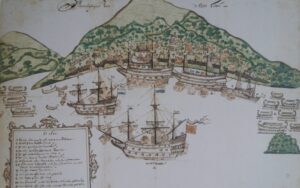An inconsequential note in Gaimard’s diary, and an expedition down another rabbit hole, and one that turned out to have multiple branching tunnels, once inside. The note was a consequence of the copying by Gaimard of items that interested him from documents held in the archives of Guam, . Concerning the population of Guam, he learned that
There is no doubt that they came from the Philippines and that, cast ashore on the Marianas by contrary winds and despairing of their return, they populated the deserted islands. Their faces and colouration are similar to those of the Visayas, although their language has changed in some respects (Gaimard, p. 399).
This theory of origin may or may not be correct, but is at least plausible since, according to the language specialists at the University of Hawaii, the Chamorro language is related to the ‘Austronesian languages of Sumba, Flores, the Moluccas, Timor, Halmahera, and also Palauan’, and Bisayan is also Austronesian. It was, however, the mention of Halmahera that struck a chord with me, because Gaimard went on to write :
It is also very likely that it was similar circumstances that brought people from Japon, Siao, Terrenate and other islands, and even the Chinese, as happened in Choco. [Gaimard, p. 400)
Is Gaimard suggesting that people from all these places had come to Guam by the time he arrived there? There is precious little evidence for their presence. His ‘Terrenate’ must surely be the small volcanic island of Ternate, which lies less than 20 km east of the west coast of Halmahera and was the centre of a considerable empire financed by the proceeds of the spice trade, as was the much less well-known Siau (surely the ‘Siao’ in this list) on the opposite side of the Molucca Sea . Guam was well beyond the furthest limits of their territorial expansion of either, but there is a third tiny island in this region that was the seat of an important ‘spice sultanate’, and it was the only one through whose territory the Uranie passed. It was the empire of the island of Tidore, a near neighbour and of similar size to Ternate, but with a sultan who looked east to Papua rather than south to Banda and Sulawesi. That vision made him the (very) nominal overlord of the Kimalaha of Guebe, the piratical chieftain who first made contact with the Uranie when it was becalmed off the south-eastern tip of Halmahera and who visited it again when it was moored at the observatory site on Lawak.
It was spice that brought Europeans to this remote corner of the Moluccas, and inevitably entangled the sultanates in the political and religious struggles of Europe. By the time of the voyage of the Uranie, the outlines of the future colonial empires had been established, with Spain nominally in control of the Philippines and the Dutch, equally nominally, the dominant power in the Moluccas,. They latter had almost, but not quite, ejected the Portuguese from the islands and had neutralised another possible rival by excahanging the island of Manhattan for Great Britain’s tenuous foothold in the Banda Islands.
Two hundred years earlier, things had been very different. Portugal was then the dominant European power in the area, and the Dutch were only just beginning to make a showing. Their second expedition to what is now Indonesia, under the command of Jacob Cornelisz van Neck, had been a very major success, and the ships that had left the Netherlands in 1598 returned home in 1599 loaded down with spices. Van Neck had also managed to strike up a relationship with the Sultan of Ternate and when, in 1601, he was back in the Moluccas, he decided to help his friend in his dispute with his neighbour and rival, and at the same time further his own country’s interests, by attacking the Portuguese fort on Tidore.
This was not a success. Van Neck lost three fingers in the battle and, once back in the Netherlands, decided to devote himself to politics, to some effect sine he became mayor of Amsterdam. For students of the voyage of the Uranie, however, that is less interesting than the picture that was made of his defeat off Tidore. It shows two Dutch ships on the attack and three Spanish-Portuguese ships forming a line of defence in front of the town, and it also shows large numbers of smaller vessels, evidently powered by oars.
They are immediately recognisable as corocores, the favoured pirate ships of the Kimalaha of Gebe.

Figure 1. The attack on Tidore, 1601. The inset at bottom left tells us that the two ships in the foreground are the Dutch ships Amsterdam and Gouda, and that the two three-masters closer to the shore are, respectively, Portuguese (on the left) and Spanish (on the right). They fly the same flags because from 1580 to 1640 Portugal was in dynastic union with Spain. What appears to be a third, smaller ship in that line are actually two vessels, one of which (the one with gunports) had been captured from the Dutch in an earlier skirmish. The other is the Spanish brig Manilio. The besieged fortress is immediately behind the Portuguese three-master.
The triumph of Tidore’s defenders was short-lived. In 1605 the Dutch were back in greater strength, and this time they were successful. Spain retaliated by attacking Ternate from the base in the Philippines, and was successful in its turn. It was not until 1660 that a clear boundary could be drawn between the Spanish sphere of influence in the Philippines and the sphere of influence of the Dutch East India Company, the VOC, in the Moluccas. That boundary exists to this day, as the maritime border between Indonesia and the Philippines.
